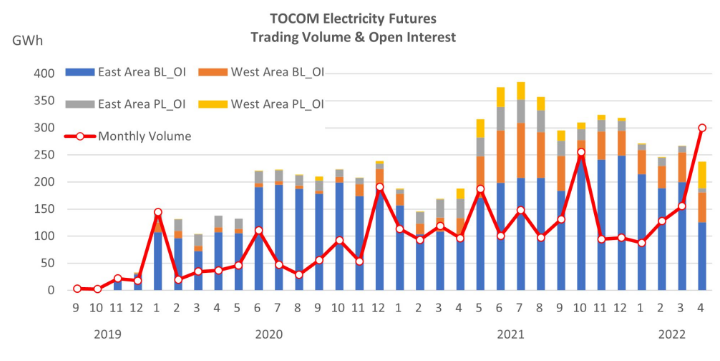TOCOM Energy
JPX Energy Market Updates(Oct. 24, 2022)
Welcome back to JPX energy market updates.
Crude oil futures last week were little changed after initially consolidating from early October levels, as a reversal in the dollar Friday sparked short-covering in crude after the dollar index fell back from a 3-week high and dropped to a 2-week low. Optimism that China will announce some easing of Covid restriction in an attempt to boost economic growth lifted optimism for Asian demand heading into the new year.
Asian oil markets closed early Friday ahead of the Singapore holiday Monday. Cash Dubai intermonth spreads continued to improve with the key M1/M3 or December and February spread up $0.40/b to $4.67/b, while JPX Dubai intermonth spread for the same period was traded around $3.5/b.
ICE Brent futures for Dec22 were valued at $92.88/b at Singapore market close, down $0.42/b from the previous Asia close and losing ground versus Dubai for the second day. The Dec22 ICE Brent/JPX Dubai spread narrowed, while the Dec22 EFS was down $0.70/b at $6.85/b.
Facing tough midterms, the US government confirmed the sale of 15 million barrels of crude oil from strategic reserves and remains open to additional sales if prices spike again while setting a repurchase price at $67-72/b. This latest release will do little to offset the impact of OPEC+ supply cuts as the release is equivalent to less than 14 days of OPEC+ supply cuts.
US dollar retreated after a report said the Federal Reserve will likely debate on a smaller interest rate hike in December, raising hopes the central bank may be poised to adopt a less aggressive policy stance although analysts widely expect the Fed to hike rates by 75 basis points for a fourth straight meeting in November.
Economies have been under pressure this year as the US central bank has embarked on an aggressive rate hike path, increasing worries of a policy error that will send the economy into a recession.
Taking the US real estate market as an example, home sales tumbled 1.5% to 4.71 million units and mortgage applications dropped 4.5% for the week ending October 14. This comes as the 30-year mortgage rate topped 7% for the first time since the early 2000s.
With expectations that the Federal Reserve will slow down the pace of interest rate increases next year, investors poured into equities and other commodity markets , resulting in substantial gains in the leading benchmark indexes.
As the northern hemisphere heading into the winter, focus of the global oil market is still on the diesel market, and fundamentals are particularly tight in the Atlantic basin.
In the U.S., weekly EIA data showed distillate stocks were little changed last week ,inventory levels remain at their lowest levels in the past decade and, inventories could fall further in line with seasonal trends. To keep domestic oil prices under control, the Biden administration is still considering restrictions on fuel exports to keep more diesel inside the United States.
In Europe, diesel stocks in northwest Europe are forecast to fall to an extremely low 210 million barrels by around February, the lowest it has been since at least 2011 according to Wood Mackenzie. That’s the month that EU sanctions on seaborne deliveries of refined products from Russia-currently the region’s single biggest external diesel supplier come into play.
Oil product loadings to EU countries fell 130 kb/d m-o-m to 965 kb/d, bringing the cumulative post-invasion loss to 550 kb/d. Diesel shipments were down by 70 kb/d m-o-m to just 510 kb/d according to IEA’s October monthly report.
With stocks at extremely low levels on both sides of the Atlantic, some tankers carrying diesel from the Middle East had changed their course mid-journey and are now traveling to the United States.
In the short term however, European diesel refiner margins tumbled to a three-week low by the end of last week as the disruption caused by French refinery strikes continued to improve, over 600,000 bpd or half of French output was offline at the height of the industrial action.
On the east side of the Suez Canal, as of October 17, stocks of middle distillates in Fujairah, including diesel and jet fuel, were reported fell by 20.1% on the week to 3.17 million barrels.
Singapore’s middle distillate inventories declined by 1.18M bbls w-o-w to 6.96M bbls during the week ending 19 October, falling to the lowest level since the week ending 8 June, according to Enterprise Singapore data.
A potential rise in China’s export might alleviate the tightness. According to data from local authority, the planned export volume of diesel oil in October is about 1.47 million tons, with a month-on-month increase of 63%. The fifth batch of quotas may be extended to the first quarter of next year, which means that domestic refined oil exports will increase in the fourth quarter of 2022.
Asian gasoil complex was expected to come under pressure with higher outflows of gasoil from China, rising supply could pressure freight rates for clean tankers higher and erode cash differentials for cargoes of gasoil. Nevertheless, the East of Suez gasoil complex is so far resilient as open arbitrage lanes to the West.






